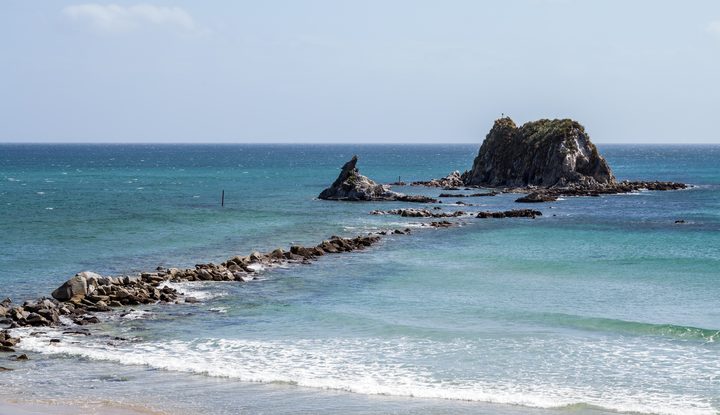Marine
heatwaves to get stronger and more common
New
international research shows marine heatwaves are becoming more
common and likely to get much stronger.

Sentinel
Rock, Mangawhai Heads.Marine heatwaves - like the one experienced in
New Zealand last summer - are likely to become more frequent and hurt
marine ecosystems. Photo: 123RF
5
March, 2019
Marine
heatwaves are smaller and more rapid changes in sea temperature that
occur during hot weather. New
Zealand experienced one last summer.
The
research, published
in Nature
Climate Change, shows the heatwaves are
54 percent more common internationally than they were 75 years ago.
And
they are likely to become more frequent and hurt marine ecosystems.
One
of the researchers, Dr Mads Thomsen from the University of
Canterbury, said marine heatwaves were first recorded in New Zealand
during last year's record-breaking summer.
Dr
Thomsen said more research was needed to understand their impact on
marine ecosystems here.
Early
evidence suggested rapid changes to local marine systems, including
plankton, fish and kelp, he said.
"Marine
ecosystems face many threats, such as invasions by non-native
species, overfishing, acidification and pollution, but shorter
periods of unusually high temperatures is now also a well-documented
cause of rapid biological changes, sometimes leading to loss of
habitat, reduced fisheries or even local extinctions."
Warmer
waters
In
general, New Zealand waters are getting warmer.
Niwa
physical oceanographer Phil Sutton was the lead author on a study
tracking ocean temperatures around New Zealand over the past 36
years.
"Since
1981 we are talking of warming of about 0.1 to 0.3 degrees Celsius
per decade. That may not sound like a huge amount but slightly
stronger warming of about 0.4C per decade off the east coast of
Tasmania has resulted in significant changes to ecosystems which has
led to concerns of similar impacts in New Zealand," Dr Sutton
said.
"The
30-year time series is long enough to see long-term changes and there
is no reason to think this will turn around."
The
strongest warming occurred off the Wairarapa coast, while the weakest
was along the north east coast between the east and north capes.
The
increased warmth penetrated in places to 200m deep while in the
Tasman Sea it reaches down to at least 850m.
The
most obvious cause? Climate change, Dr Sutton said.
It's
not just happening here, either.
The
world's oceans are warming about 40 percent more quickly than
previously thought.
Dr
Victoria Metcalf works in the Office of the Prime Minister's Chief
Science Advisor and said warmer seas could result in undesirable
species coming to New Zealand waters.
"When
they come down into an ecosystem which they previously haven't been a
member of they can upset the balance of that ecosystem, so you may
see you know, predatory activity occurring.
"There
could be a new sea urchin species that ends up here and contributes
to the kina barrens and the devastation of the kelp forests, that
sort of thing."
Warming
seas could effect "every species", she said.
"You
could see a shift in plankton blooms, plankton being the primary
producers at the bottom of the food chain and again, I think from the
satellite data we are already seeing some shifts in that … you muck
with the primary producers and you muck with everything else in the
ecosystem."
It
wouldn't take long to have an impact.
"Small
shifts can - pretty much within a season but definitely within a
decade - result in significant changes."
But
there would be winners and losers.
"Some
species actually benefit from a change in conditions. So it's not a
one size fits all response."





No comments:
Post a Comment
Note: only a member of this blog may post a comment.